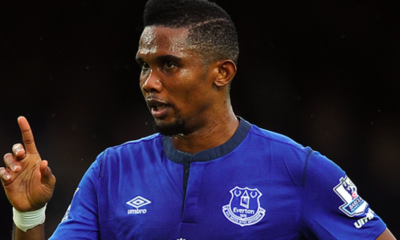Football
Meet the World Football Celebrities and Their Stories

Meet the World Football Celebrities and Their Stories
Football, often hailed as the world’s most beloved sport, has produced a plethora of celebrities whose influence stretches far beyond the pitch. These iconic figures, renowned for their extraordinary talent and captivating performances, have become global ambassadors of the beautiful game.
From the early legends to contemporary superstars, football celebrities have shaped the sport’s history and continue to inspire millions of fans worldwide.
Legends of the Game
The history of football is adorned with legendary figures like Pelé, Diego Maradona, and Johan Cruyff. These pioneers not only dazzled with their skills but also revolutionized the way football is played and perceived. Their contributions laid the foundation for the sport’s global appeal and set high standards for future generations.
Modern-Day Icons
In the modern era, players like Lionel Messi and Cristiano Ronaldo have taken the mantle, showcasing unparalleled consistency and excellence. Their rivalry has captivated audiences, driving the sport to new heights of popularity. Alongside them, stars such as Neymar, Kylian Mbappé, and Mohamed Salah have emerged, each bringing their unique flair and charisma to the global stage.
The Global Influence
Football celebrities are not confined to their countries of origin; they are celebrated worldwide. They transcend cultural and linguistic barriers, uniting fans across continents. Their influence is seen not only in their home countries but also in the global markets they penetrate, from Europe and South America to Asia and Africa.
Beyond the Pitch
These athletes are more than just footballers; they are cultural icons and role models. They engage in philanthropic efforts, launch fashion lines, and advocate for social causes, leveraging their fame to make a positive impact. Their lives off the pitch often garner as much attention as their sporting exploits, further solidifying their status as global celebrities.
Continual Evolution
As the sport evolves, so too do its stars. The next generation of footballers is already making its mark, inspired by the legends before them. Young talents like Erling Haaland and Ansu Fati represent the future of football, carrying forward the legacy of their predecessors while paving the way for new innovations and achievements.
Here’s a list of some football celebrities, past and present, who have made a significant impact on the sport:
- Pele: Regarded as one of the greatest footballers of all time, Pele won three FIFA World Cups with Brazil and scored over 1,000 career goals.
- Diego Maradona: Known for his “Hand of God” goal and “Goal of the Century” in the 1986 World Cup, Maradona is considered one of the greatest players in football history.
- Lionel Messi: A record-breaking forward who has won numerous Ballon d’Or awards, Messi is known for his exceptional dribbling and goal-scoring abilities.
- Cristiano Ronaldo: Another prolific goal scorer, Ronaldo has won multiple Ballon d’Or awards and has had successful stints with clubs like Manchester United, Real Madrid, and Juventus.
- Zinedine Zidane: A French football legend known for his elegance on the ball, Zidane won the FIFA World Cup with France in 1998 and has had success as both a player and a coach.
- Ronaldinho: A Brazilian playmaker known for his flair and skill, Ronaldinho won the FIFA World Player of the Year award twice and entertained fans around the world with his style of play.
- David Beckham: An English midfielder known for his passing and free-kick ability, Beckham played for clubs like Manchester United, Real Madrid, and LA Galaxy, and was also known for his fashion and celebrity status off the field.
- Neymar Jr.: A Brazilian forward known for his skillful dribbling and creativity, Neymar has played for clubs like Barcelona and Paris Saint-Germain, and is considered one of the best players in the world.
- Ronaldo Nazario: Often referred to as “Ronaldo”, the Brazilian striker was known for his pace, power, and goal-scoring prowess, winning two FIFA World Cup titles and multiple individual awards.
- Thierry Henry: A French striker known for his speed and goal-scoring ability, Henry had successful spells with clubs like Arsenal and Barcelona and is considered one of the greatest Premier League players of all time.
- Franz Beckenbauer: A German footballer known for his elegance and versatility, Beckenbauer won the FIFA World Cup both as a player and as a coach, and is considered one of the greatest defenders of all time.
- Johan Cruyff: A Dutch footballer and coach known for his innovative playing style and vision, Cruyff was a key figure in the development of “Total Football” and won numerous titles with Ajax and Barcelona.
- George Best: A Northern Irish winger known for his dribbling ability and flair, Best played for Manchester United and is often regarded as one of the greatest footballers of all time.
- Bobby Charlton: An English midfielder known for his long-range shooting and passing ability, Charlton won the FIFA World Cup with England in 1966 and had a successful career with Manchester United.
- Garrincha: A Brazilian winger known for his dribbling skills and agility, Garrincha won two FIFA World Cups with Brazil and is considered one of the best dribblers in football history.
- Michel Platini: A French midfielder known for his leadership and goal-scoring ability, Platini won multiple Ballon d’Or awards and had success with clubs like Juventus and the French national team.
- Marco van Basten: A Dutch striker known for his clinical finishing and technical ability, Van Basten won multiple Ballon d’Or awards and had success with clubs like AC Milan and the Netherlands national team.
- Ferenc Puskas: A Hungarian forward known for his goal-scoring prowess, Puskas played for clubs like Real Madrid and is considered one of the greatest players of all time.
- Lev Yashin: A Soviet goalkeeper known for his acrobatic saves and commanding presence, Yashin is the only goalkeeper to have won the Ballon d’Or and is regarded as one of the greatest goalkeepers in football history.
- Ruud Gullit: A Dutch midfielder known for his versatility and skill, Gullit won the Ballon d’Or in 1987 and had success with clubs like AC Milan and the Netherlands national team.
- Gerd Muller: A German striker known for his goal-scoring ability and clinical finishing, Muller won the FIFA World Cup with West Germany in 1974 and had a prolific career with Bayern Munich.
- Eusebio: A Portuguese forward known for his speed and goal-scoring prowess, Eusebio was a prolific scorer for Benfica and the Portugal national team.
- Roberto Baggio: An Italian forward known for his skill and creativity, Baggio won the FIFA World Player of the Year award in 1993 and had success with clubs like Juventus and AC Milan.
- Xavi Hernández: A Spanish midfielder known for his passing and vision, Xavi was a key player for Barcelona and the Spain national team, winning numerous titles including the FIFA World Cup and UEFA European Championship.
- Andres Iniesta: Another Spanish midfielder known for his skill and creativity, Iniesta played alongside Xavi at Barcelona and won multiple titles with the club and the national team.
- Paolo Maldini: An Italian defender known for his leadership and defensive abilities, Maldini spent his entire career with AC Milan and is considered one of the greatest defenders of all time.
- Zico: A Brazilian midfielder known for his technical ability and free-kick prowess, Zico played for clubs like Flamengo and the Brazil national teams and is considered one of the greatest players of his generation.
- Socrates: A Brazilian midfielder known for his intelligence on and off the field, Socrates was a key player for Brazil and played for clubs like Corinthians and Fiorentina.
- Rivaldo: A Brazilian forward known for his skill and goal-scoring ability, Rivaldo won the FIFA World Player of the Year award in 1999 and had success with clubs like Barcelona and AC Milan.
- George Weah: A Liberian striker known for his pace and goal-scoring ability, Weah won the FIFA World Player of the Year award in 1995 and had success with clubs like AC Milan and Paris Saint-Germain.
- Hristo Stoichkov: A Bulgarian forward known for his skill and tenacity, Stoichkov won the Ballon d’Or in 1994 and had success with clubs like Barcelona and the Bulgaria national team.
- Gianluigi Buffon: An Italian goalkeeper known for his shot-stopping ability and leadership, Buffon has had a long and successful career with clubs like Juventus and the Italy national team.
- Fabio Cannavaro: An Italian defender known for his defensive prowess and leadership, Cannavaro won the FIFA World Player of the Year award in 2006 and had success with clubs like Juventus and Real Madrid.
- Alessandro Del Piero: An Italian forward known for his skill and goal-scoring ability, Del Piero had a successful career with Juventus and the Italy national team, winning numerous titles.
- Luis Figo: A Portuguese midfielder known for his skill and versatility, Figo won the FIFA World Player of the Year award in 2001 and had success with clubs like Barcelona and Real Madrid.
- Michael Ballack: A German midfielder known for his leadership and technical ability, Ballack had success with clubs like Bayern Munich and Chelsea, as well as the German national team.
- Fernando Torres: A Spanish striker known for his speed and goal-scoring ability, Torres had success with clubs like Atletico Madrid, Liverpool, and the Spain national team.
- Franco Baresi: An Italian defender known for his elegance and reading of the game, Baresi spent his entire career with AC Milan and is considered one of the greatest defenders of all time.
- Raul Gonzalez: A Spanish forward known for his goal-scoring ability and leadership, Raul spent the majority of his career with Real Madrid and is one of the club’s all-time leading goals scorers.
- Kaka: A Brazilian midfielder known for his skill and vision, Kaka won the FIFA World Player of the Year award in 2007 and had success with clubs like AC Milan and Real Madrid.
- Andrea Pirlo: An Italian midfielder known for his passing and vision, Pirlo had success with clubs like AC Milan and Juventus, as well as the Italy national team.
- Carlos Valderrama: A Colombian midfielder known for his skill and creativity, Valderrama was a key player for the Colombia national team and had success with clubs like Atletico Junior and the Tampa Bay Mutiny.
- Peter Schmeichel: A Danish goalkeeper known for his shot-stopping ability and commanding presence, Schmeichel had success with clubs like Manchester United and the Denmark national team.
- Ruud van Nistelrooy: A Dutch striker known for his goal-scoring ability, Van Nistelrooy had success with clubs like Manchester United and Real Madrid, as well as the Netherlands national team.
- Fernando Hierro: A Spanish defender and midfielder known for his leadership and versatility, Hierro had success with clubs like Real Madrid and the Spain national team.
- Rui Costa: A Portuguese midfielder known for his skill and vision, Costa had success with clubs like Benfica, Fiorentina, and AC Milan, as well as the Portugal national team.
- Roberto Carlos: A Brazilian left-back known for his powerful free kicks and attacking prowess, Carlos had success with clubs like Real Madrid and the Brazil national team.
- Patrick Vieira: A French midfielder known for his physicality and leadership, Vieira had success with clubs like Arsenal and Inter Milan, as well as the France national team.
- Pavel Nedved: A Czech midfielder known for his skill and work rate, Nedved had success with clubs like Lazio and Juventus, as well as the Czech Republic national team.
- Cafu: A Brazilian full-back known for his pace and attacking prowess, Cafu won the FIFA World Cup twice with Brazil and had success with clubs like AS Roma and AC Milan.
- Alessandro Nesta: An Italian defender known for his elegance and defensive abilities, Nesta had success with clubs like Lazio and AC Milan, as well as the Italy national team.
- Didier Drogba: An Ivorian striker known for his physicality and goal-scoring ability, Drogba had success with clubs like Chelsea and Galatasaray, as well as the Ivory Coast national team.
- Samuel Eto’o: A Cameroonian striker known for his pace and goal-scoring ability, Eto’o had success with clubs like Barcelona and Inter Milan, as well as the Cameroon national team.
Conclusion
In conclusion, football celebrities are more than just athletes; they are symbols of excellence, perseverance, and influence. Their contributions to the sport and society at large have cemented their status as global icons.
As we celebrate their achievements, we also recognize the enduring legacy they leave, inspiring future generations to carry the torch of the beautiful game forward. The world of football is richer, and more vibrant because of these extraordinary individuals, and their impact will be felt for many years to come.
Football
Euro 2024 Power Rankings: Spain Remains Dominant Ahead of Semifinals

Euro 2024 Power Rankings: Spain Remains Dominant Ahead of Semifinals
As Euro 2024 advances to its thrilling semifinal stage, the competition has been nothing short of electrifying. Teams have showcased their prowess on the field, with each match contributing to the ever-evolving power rankings. Spain continues to dominate, holding the top spot as they prepare to face formidable opponents.
This article delves into the performances of the leading teams, the key players who have shone, and the factors that have influenced these rankings.
Spain: The Unwavering Titans
Consistent Dominance
Spain has consistently demonstrated why they are considered one of the favorites to win Euro 2024. Their tactical acumen, coupled with an impressive roster, has made them a formidable opponent. Spain’s journey through the tournament has been marked by clinical performances and strategic brilliance.
Key Players
- Pedri: The young midfielder has been a revelation, dictating play with his vision and technical skills. His ability to control the tempo of the game has been crucial for Spain.
- Alvaro Morata: Despite facing criticism, Morata has been pivotal in leading the attack, scoring crucial goals and creating opportunities for his teammates.
Tactical Mastery
Spain’s tactical approach, under the guidance of their experienced coach, has been impeccable. Their possession-based style, high pressing, and quick transitions have left opponents struggling to keep up.
France: The Powerhouse Contenders
Strength in Depth
France has showcased their strength in depth throughout the tournament. Their squad, brimming with world-class talent, has navigated through challenging fixtures with relative ease.
Key Players
- Kylian Mbappe: The star forward has lived up to expectations, delivering match-winning performances with his blistering pace and clinical finishing.
- N’Golo Kante: Kante’s defensive prowess and tireless work rate have been instrumental in breaking up opposition attacks and maintaining midfield stability.
Strategic Flexibility
France’s ability to adapt their tactics to different opponents has been a key factor in their success. Their versatility, combined with individual brilliance, has made them a daunting prospect for any team.
England: The Resilient Challengers
A Blend of Youth and Experience
England has struck a balance between youthful exuberance and experienced heads. This blend has propelled them into the semifinals, with standout performances across the squad.
Key Players
- Harry Kane: The captain has led by example, scoring vital goals and providing leadership on and off the pitch.
- Phil Foden: The young midfielder has dazzled with his creativity and flair, becoming a key figure in England’s attacking setup.
Solid Defensive Setup
England’s defensive solidity has been a cornerstone of their success. Their well-organized backline and disciplined approach have frustrated opponents, limiting their goal-scoring opportunities.
Netherlands: The Dark Horses
Surprise Package
The Netherlands have emerged as the dark horses of Euro 2024. Despite being underdogs, their spirited performances have earned them a place in the semifinals.
Key Players
- Memphis Depay: Depay’s flair and goal-scoring ability have been vital for the Netherlands, providing them with a cutting edge in attack.
- Frenkie de Jong: The midfielder’s composure and playmaking skills have been crucial in controlling the midfield and dictating the pace of the game.
Team Cohesion
The Netherlands’ success can be attributed to their strong team cohesion and collective effort. Their ability to work as a unit has compensated for any perceived lack of individual star power.
Portugal: The Ronaldo Factor
Ronaldo’s Influence
Cristiano Ronaldo continues to be a driving force for Portugal. His leadership and goal-scoring prowess have been pivotal in their journey to the semifinals.
Key Players
- Bruno Fernandes: Fernandes’ creativity and vision have provided Portugal with a dynamic edge in the attacking third.
- Ruben Dias: The defender’s solidity at the back has been crucial in ensuring Portugal’s defensive resilience.
Tactical Discipline
Portugal’s tactical discipline, combined with Ronaldo’s brilliance, has seen them navigate through tough matches. Their structured approach and ability to capitalize on key moments have been instrumental.
Italy: The Tactical Maestros
Defensive Solidity
Italy’s defensive solidity has been a hallmark of their Euro 2024 campaign. Their well-drilled backline and tactical organization have made them difficult to break down.
Key Players
- Giorgio Chiellini: The veteran defender has led by example, marshalling the defense with authority and experience.
- Lorenzo Insigne: Insigne’s creativity and goal-scoring ability have provided Italy with a crucial attacking outlet.
Tactical Brilliance
Italy’s tactical brilliance, under their astute coach, has been evident in their game management and strategic execution. Their ability to control matches and exploit weaknesses has been key to their success.
Germany: The Rebuilding Giants
Rejuvenation and Youth
Germany has undergone a period of rejuvenation, integrating young talents into the squad. This blend of youth and experience has brought fresh energy and dynamism to the team.
Key Players
- Joshua Kimmich: Kimmich’s versatility and leadership have been central to Germany’s midfield dominance.
- Serge Gnabry: Gnabry’s pace and goal-scoring ability have added a new dimension to Germany’s attack.
Strategic Rebuild
Germany’s strategic rebuild, focusing on youth development and tactical innovation, has laid the foundation for their resurgence. Their progress in Euro 2024 is a testament to this vision.
Belgium: The Golden Generation
Experienced Core
Belgium’s golden generation, featuring experienced stars, has once again demonstrated their quality. Their journey to the semifinals has been marked by impressive performances and resilience.
Key Players
- Kevin De Bruyne: De Bruyne’s playmaking skills and vision have been instrumental in orchestrating Belgium’s attacks.
- Romelu Lukaku: Lukaku’s physical presence and goal-scoring prowess have been vital for Belgium’s success.
Tactical Adaptability
Belgium’s tactical adaptability, combined with their experienced core, has allowed them to navigate through challenging fixtures. Their ability to adjust their game plan has been a key factor in their progress.
Croatia: The Resilient Warriors
Never-Say-Die Attitude
Croatia’s never-say-die attitude has seen them through to the semifinals. Their resilience and fighting spirit have been on full display throughout the tournament.
Key Players
- Luka Modric: The veteran midfielder continues to be the heartbeat of the team, dictating play with his vision and composure.
- Ivan Perisic: Perisic’s versatility and goal-scoring ability have provided Croatia with crucial attacking options.
Collective Effort
Croatia’s success has been a result of collective effort and determination. Their ability to rise to the occasion and perform under pressure has been commendable.
Semifinal Predictions and Prospects
Spain vs. Netherlands
Spain’s tactical superiority and depth in squad make them favorites against the Netherlands. However, the Dutch team’s cohesion and fighting spirit could spring a surprise.
France vs. England
The clash between France and England promises to be a thrilling encounter. Both teams have shown exceptional quality, and the outcome may hinge on individual brilliance and tactical execution.
Conclusion
As Euro 2024 heads into the semifinals, the excitement and anticipation continue to build. Spain remains the team to beat, but the competition is fierce, with each semifinalist bringing unique strengths and qualities to the table. The journey so far has been a testament to the skill, strategy, and resilience of these top teams. As fans, we can look forward to thrilling matches and unforgettable moments as the tournament reaches its climax.
Frequently Asked Questions (FAQs)
Who are the key players to watch in the Euro 2024 semifinals?
Key players to watch include Spain’s Pedri, France’s Kylian Mbappe, England’s Harry Kane, and the Netherlands’ Memphis Depay. Each of these players has significantly impacted their teams’ performances.
How has Spain maintained its top position in the power rankings?
Spain has maintained its top position through consistent performances, tactical brilliance, and the contributions of key players like Pedri and Alvaro Morata.
What factors contribute to a team’s success in Euro 2024?
Factors contributing to a team’s success include tactical strategy, individual brilliance, team cohesion, and the ability to adapt to different opponents and match situations.
How has France’s versatility helped them in the tournament?
France’s versatility has allowed them to adapt their tactics to different opponents, making them a formidable and unpredictable team. This adaptability has been crucial in their journey to the semifinals.
What are the prospects for the semifinal match between France and England?
The semifinal match between France and England promises to be highly competitive. Both teams have shown exceptional quality, and the outcome may depend on tactical execution and moments of individual brilliance.
For more information, visit the original article on ESPN.
Football
Euro 2024: Alvaro Morata Speaks Out About ‘No Respect’ in Spain

Euro 2024: Alvaro Morata Speaks Out About ‘No Respect’ in Spain
Alvaro Morata, a prominent figure in Spanish football, has recently voiced his frustrations regarding the lack of respect he feels he receives in his home country. As Spain gears up for Euro 2024, Morata’s statements have sparked widespread discussion and debate among fans, pundits, and the media. This article delves into the context of Morata’s comments, his career journey, the implications for Spain’s national team, and the broader impact on football culture in Spain.
Alvaro Morata: A Brief Overview
Early Career and Rise to Prominence
Alvaro Morata began his professional career with Real Madrid, where he quickly made a name for himself with his exceptional goal-scoring abilities and versatility on the field. His performances earned him a move to Juventus, where he continued to flourish, winning multiple titles and establishing himself as one of Europe’s top strikers.
Return to Real Madrid and Subsequent Moves
After a successful stint in Italy, Morata returned to Real Madrid, but his second spell at the club was marred by inconsistent performances and limited playing time. Seeking more opportunities, Morata moved to Chelsea in the Premier League, and later to Atletico Madrid, where he has played a crucial role in their attacking line-up.
Morata’s Impact on the Spanish National Team
Consistent Selection and Performance
Despite the ups and downs in his club career, Morata has been a consistent presence in the Spanish national team. Known for his clinical finishing and ability to perform in high-pressure situations, he has often been Spain’s go-to forward in major tournaments.
Controversial Moments and Criticism
However, Morata’s international career has not been without controversy. He has faced significant criticism from fans and media, particularly during periods of poor form. This criticism has sometimes crossed the line, affecting Morata’s mental health and performance on the field.
The ‘No Respect’ Comment: Analyzing the Context
Frustrations with Media and Fans
In his recent comments, Morata expressed frustration with the lack of respect he feels from Spanish fans and media. He highlighted how negative coverage and undue criticism have taken a toll on him personally and professionally. Morata’s statements reflect a broader issue within football culture, where players often face harsh scrutiny.
Support from Teammates and Coaches
Despite the criticism, Morata has received strong support from his teammates and coaches. Key figures in the Spanish football community have defended him, emphasizing his contributions to the national team and his dedication to the sport.
Implications for Spain’s Euro 2024 Campaign
Morata’s Role and Importance
As Spain prepares for Euro 2024, Morata’s role will be crucial. His experience, goal-scoring prowess, and leadership qualities make him an invaluable asset for the team. The coaching staff will need to ensure he feels supported and respected to get the best out of him.
Team Dynamics and Morale
Morata’s comments have also brought to light issues related to team dynamics and morale. The Spanish national team will need to foster a positive environment where all players feel valued and respected. This is essential for building team cohesion and achieving success in the tournament.
The Broader Impact on Football Culture in Spain
Media Responsibility and Ethics
Morata’s criticisms have sparked a debate about the role of the media in shaping public perceptions of players. There is a growing call for more responsible and ethical journalism that prioritizes fair and balanced coverage over sensationalism and negativity.
Fan Behavior and Expectations
Fans also play a crucial role in shaping the experiences of football players. Morata’s comments serve as a reminder that fans’ expectations and behavior can significantly impact players’ mental health and performance. Promoting a culture of respect and support is essential for the well-being of athletes.
Strategies for Overcoming Criticism
Mental Health Support for Players
Addressing the mental health needs of football players is crucial. Clubs and national teams need to provide comprehensive support systems, including access to sports psychologists and mental health professionals, to help players cope with the pressures of the game.
Building Resilience and Coping Mechanisms
Players also need to develop resilience and effective coping mechanisms to deal with criticism. This includes focusing on personal strengths, setting realistic goals, and maintaining a positive mindset despite external negativity.
Morata’s Response and Future Prospects
Determination to Succeed
Despite the challenges, Morata has shown remarkable determination to succeed. His focus remains on performing well for his club and country, proving his critics wrong, and continuing to contribute to the success of his teams.
Potential Career Moves
Looking ahead, Morata’s career could see further changes. Whether he stays at Atletico Madrid or moves to another club, his experiences will undoubtedly shape his future endeavors in football.
Conclusion
Alvaro Morata’s comments about feeling disrespected in Spain have highlighted significant issues within football culture, including media ethics, fan behavior, and player mental health. As Spain prepares for Euro 2024, supporting Morata and fostering a positive team environment will be crucial for their success. His journey serves as a reminder of the challenges athletes face and the importance of respect and support from all corners of the football community.
Frequently Asked Questions (FAQs)
What did Alvaro Morata say about the lack of respect in Spain?
Alvaro Morata expressed frustration with the lack of respect he feels from Spanish fans and media, highlighting how negative coverage and undue criticism have affected him personally and professionally.
How has Morata’s club career influenced his international performances?
Morata’s club career has seen highs and lows, but he has remained a consistent presence in the Spanish national team, known for his clinical finishing and ability to perform in high-pressure situations.
How can the media contribute to a positive football culture?
The media can contribute to a positive football culture by prioritizing fair and balanced coverage, avoiding sensationalism, and focusing on the achievements and contributions of players rather than undue criticism.
What role will Morata play in Spain’s Euro 2024 campaign?
Morata will play a crucial role in Spain’s Euro 2024 campaign as an experienced forward with goal-scoring prowess and leadership qualities, making him an invaluable asset for the team.
What steps can be taken to support football players’ mental health?
Supporting football players’ mental health involves providing access to sports psychologists, fostering a positive team environment, promoting respect and support from fans and media, and helping players develop resilience and effective coping mechanisms.
For more information, visit the original article on ESPN.
Football
Ronaldo’s Business Ventures and Investments (CR7 Brand)

Ronaldo’s Business Ventures and Investments (CR7 Brand)
Cristiano Ronaldo, a name synonymous with excellence in football, has successfully ventured beyond the pitch to establish himself as a formidable entrepreneur. The CR7 brand is not just a testament to his prowess in the sport but also his acumen in the business world. Let’s delve into the various facets of Ronaldo’s business ventures and investments, exploring how he has built an empire that transcends football.
The Genesis of CR7: A Global Phenomenon
The Birth of a Brand
Cristiano Ronaldo’s journey from a young boy in Madeira to a global icon is nothing short of inspirational. His brand, CR7, embodies his dedication, hard work, and relentless pursuit of excellence. The inception of CR7 marked the beginning of Ronaldo’s foray into the business world, leveraging his massive popularity and influence.
Early Endorsements and Partnerships
Before the establishment of his own brand, Ronaldo was already a hot commodity in the endorsement world. Major brands like Nike, Coca-Cola, and Armani recognized his marketability early on. These endorsements not only boosted his income but also laid the groundwork for his business ventures.
CR7: Expanding Horizons

CR7 Footwear and Apparel
The CR7 brand started with a focus on footwear and apparel. Ronaldo’s unique sense of style and fashion made this venture a natural extension of his personality. The CR7 clothing line includes a range of stylish and comfortable outfits, catering to both casual wear and sportswear enthusiasts.
Footwear
The CR7 footwear line offers a variety of options, from casual sneakers to high-performance sports shoes. Designed with Ronaldo’s input, these shoes reflect his athletic style and are crafted for comfort and durability.
Apparel
The CR7 apparel line includes everything from jeans and shirts to underwear. Each piece is designed to reflect Ronaldo’s signature style, combining elegance with practicality.
CR7 Underwear: A Bold Move

Creating a Niche Market
One of Ronaldo’s most successful ventures has been the CR7 underwear line. Launched with much fanfare, this line has become synonymous with comfort and quality. The CR7 underwear line caters to a broad audience, offering a range of options for men and boys.
Innovative Marketing Strategies
Ronaldo’s marketing strategies for the underwear line have been innovative and bold. Using his own image as the face of the brand, Ronaldo has managed to create a personal connection with consumers, enhancing brand loyalty and recognition.
Real Estate Investments: Building an Empire

Hotels and Resorts
Ronaldo has made significant investments in the hospitality industry. His chain of hotels, under the Pestana CR7 brand, is a testament to his vision of creating luxurious and comfortable accommodations. These hotels, located in prime destinations like Madeira, Lisbon, and New York, offer guests a unique blend of Ronaldo’s flair and hospitality.
Real Estate Holdings
In addition to hotels, Ronaldo has invested heavily in real estate. His portfolio includes luxury apartments, villas, and commercial properties across the globe. These investments not only provide substantial returns but also diversify his income streams.
Fitness and Wellness: A Passion Turned Business

CR7 Fitness Gyms
Ronaldo’s passion for fitness is well-known, and he has translated this passion into a successful business venture. The CR7 Fitness Gyms, located in various cities, offer state-of-the-art equipment and facilities. These gyms reflect Ronaldo’s commitment to health and fitness, providing members with an environment that encourages them to achieve their fitness goals.
Health Supplements and Products
In line with his fitness ventures, Ronaldo has also invested in health supplements and wellness products. The CR7 Drive, an energy drink developed in collaboration with Herbalife, is designed to enhance athletic performance and hydration. This product is a part of Ronaldo’s broader strategy to promote a healthy lifestyle.
Technology and Digital Ventures

Mobile Apps and Digital Platforms
Ronaldo has also ventured into the digital space, recognizing the potential of technology in today’s world. He has launched several mobile apps and digital platforms aimed at engaging with his fans and promoting his brand. The CR7 Selfie app, for instance, allows fans to take virtual selfies with Ronaldo, enhancing their connection with the star.
E-Sports and Gaming
The world of e-sports and gaming is another area where Ronaldo has made his mark. He has invested in e-sports teams and gaming platforms, leveraging his popularity among younger audiences to create a successful business model.
Philanthropy: Giving Back to Society
Charitable Foundations
Beyond his business ventures, Ronaldo is also known for his philanthropic efforts. He has established several charitable foundations aimed at improving the lives of underprivileged children and communities. The CR7 Foundation focuses on providing education, healthcare, and sports opportunities to children around the world.
Donations and Fundraising
Ronaldo is actively involved in various fundraising activities and has made substantial donations to numerous causes. His commitment to giving back to society is a key aspect of his legacy, reflecting his belief in using his success to make a positive impact on the world.
The Future of CR7: Continuing the Legacy
Expansion Plans
The future of the CR7 brand looks promising, with plans for further expansion in various sectors. Ronaldo’s team is constantly exploring new opportunities and markets, ensuring that the brand remains relevant and competitive.
Sustainable Business Practices
In line with global trends, the CR7 brand is also focusing on sustainability. Efforts are being made to incorporate eco-friendly practices in manufacturing and operations, ensuring that the brand contributes positively to the environment.
Innovation and Adaptation
Ronaldo’s ability to innovate and adapt has been a key factor in his success. The CR7 brand continues to evolve, embracing new technologies and trends to stay ahead of the competition. This forward-thinking approach ensures that the brand remains a leader in the industry.
Conclusion
Cristiano Ronaldo’s journey from a football legend to a successful entrepreneur is a testament to his determination, vision, and business acumen. The CR7 brand, encompassing a diverse range of ventures, reflects his multifaceted personality and commitment to excellence. As Ronaldo continues to expand his empire, the CR7 brand stands as a symbol of his enduring legacy both on and off the pitch.
Frequently Asked Questions (FAQs)
1. What is the CR7 brand?
The CR7 brand is a business venture established by Cristiano Ronaldo, encompassing a range of products and services, including clothing, footwear, underwear, hotels, gyms, and more.
2. How did Ronaldo start his business ventures?
Ronaldo started his business ventures with endorsements and partnerships with major brands. He later expanded into his own brand, CR7, leveraging his popularity and influence.
3. What are some of the products offered by the CR7 brand?
The CR7 brand offers a variety of products, including footwear, apparel, underwear, and health supplements. Additionally, Ronaldo has invested in hotels, gyms, and digital ventures.
4. How successful is the CR7 brand?
The CR7 brand is highly successful, generating significant revenue and expanding into various sectors. Ronaldo’s business acumen and marketability have played a crucial role in the brand’s success.
5. What philanthropic efforts is Ronaldo involved in?
Ronaldo is involved in several philanthropic efforts through the CR7 Foundation, focusing on providing education, healthcare, and sports opportunities to underprivileged children and communities worldwide.
6. What is the Pestana CR7 brand?
Pestana CR7 is a chain of hotels owned by Cristiano Ronaldo in partnership with the Pestana Hotel Group. These hotels are located in prime destinations and offer luxury accommodations.
7. What is CR7 Drive?
CR7 Drive is an energy drink developed by Cristiano Ronaldo in collaboration with Herbalife. It is designed to enhance athletic performance and hydration.
8. How does Ronaldo promote the CR7 brand?
Ronaldo promotes the CR7 brand through innovative marketing strategies, including using his image and personal connection with fans. He also leverages digital platforms and social media to engage with his audience.
9. What are Ronaldo’s plans for the future of the CR7 brand?
Ronaldo plans to expand the CR7 brand further into various sectors, focusing on sustainability and innovation to stay ahead of the competition and ensure long-term success.
10. How does Ronaldo balance his football career and business ventures?
Ronaldo balances his football career and business ventures by delegating responsibilities to a competent team of professionals and maintaining a disciplined and organized approach to his endeavors.
-

 NBA5 months ago
NBA5 months agoLaMelo Ball Net Worth: A Comprehensive Look at the NBA Star’s Financial Empire
-

 Football6 months ago
Football6 months agoEuro 2024: Alvaro Morata Speaks Out About ‘No Respect’ in Spain
-

 Game6 months ago
Game6 months agoThe Ultimate Guide to General Multi-Sport Events
-

 Football7 months ago
Football7 months agoSamuel Eto’o: Legendary Cameroonian Soccer Star’s Career
-

 Football6 months ago
Football6 months agoRonaldo’s Business Ventures and Investments (CR7 Brand)
-

 Wrestling3 months ago
Wrestling3 months agoJey Uso Biography and Net Worth: The Rise of a WWE Superstar
-

 Wrestling4 months ago
Wrestling4 months agoKevin Owens: The Prizefighter’s Rise to Fame and Fortune
-

 Football6 months ago
Football6 months agoEuro 2024 Power Rankings: Spain Remains Dominant Ahead of Semifinals





